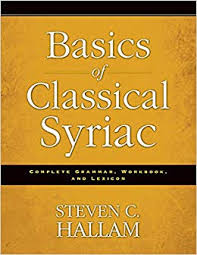Hallam, Steven C. Basics of Classical Syriac: Complete Grammar, Workbook, and Lexicon. Grand Rapids, MI: Zondervan, 2016, pp. 318, $49.99, paperback.
Steven C. Hallam is Assistant Professor and Chair of the General Studies department at Alaska Christian College in Soldotna, Alaska. He earned his PhD from Golden Gate Baptist Theological Seminary and has taught courses in Greek, Hebrew, Aramaic, and Syriac. His Syriac grammar is the most recent addition to Zondervan’s language series of grammars and workbooks, and its stated aim is to get students reading the Syriac Peshitta as quickly as possible (p. 10).
The grammar follows a standard layout, with specific sections on the nominal system (chapters 1-6), the G-stem of the verbal system (chapters 7-11), the derived stems of the verbal system (chapters 12-16), and weak verbs (chapters 17-23). Each chapter concludes with a vocabulary list specifically relevant for interpreting the New Testament Peshitta and a set of exercises. Hallam also includes several appendices that recommend resources for further study, provide a summary of all relevant paradigms, and that presents a comparison chart of the three Classical Syriac scripts.
Syriac literature, of course, is written in three main scripts: Esṭrangelā, Western, and Eastern. Hallam takes a unique approach compared to other grammars in that he utilizes a mix of two scripts. The consonants throughout the grammar are written in Esṭrangelā, while the vowel pointing uses the Western script. This combination is not found in any actual Syriac texts, but the pedagogical purpose is to introduce the student to both the oldest and most important script for biblical studies (Esṭrangelā), and the most common vowel pointing used in scholarly writing (Western). The exercises at the end of the chapters are in a pointed and unpointed form, so if students practice both, the mixed script should not present them with any problems in reading Syriac texts.
The greatest strength of the grammar is the numerous exercises provided that allow students to read portions of the Peshitta early on. Additionally, the grammar intentionally tries to simplify and generalize certain grammatical principles for ease of learning. But this latter point may also be a limitation. For example, Hallam chooses not to use the quššāyā and rukkākā (dots indicating soft or hard pronunciation for begadkepat letters) in the paradigms, but includes them in the exercises. The intention is to simplify phonetic concepts, but this is such a fundamental point of phonology that leaving it out can actually create unnecessary confusion.
Readers should also be aware that this grammar is not intended to be used apart from other reference grammars. Hallam specifically recommends reading Nöldeke’s Compendious Syriac Grammar in conjunction with his own for a better understanding of the grammatical points that are made (p. 10). Even with this concession, however, there are other unfortunate reasons why an additional grammar is needed.
The grammar, as it stands, has several editorial errors in both the English and Syriac portions. For a student, the English errors are minor, and Hallam’s intended meaning can still be discerned. For example, when discussing pronominal suffixes, Hallam states that “feminine verbs are formed regularly after the same pattern as the masculine,” though he clearly means feminine nouns (p. 61). Moreover, he points out that the 3fs and 2fs G-stem imperfect forms are identical when he actually means the 3fs and 2ms forms (p. 106). English editing mistakes like this are not uncommon, but the most problematic are the Syriac mistakes.
For example, the paradigm for the copulative hwā has an error in the 3fp form. The form given is hwāy with the vowel as zqāphā (p. 83). It should be hway with the vowel as pthāḥā. The same mistake is also found in the similar paradigm of enclitic hwā (p. 85). Additionally, the paradigm of the Peal imperative with an a-stem vowel should use a different word as an example (p. 117). Hallam uses the verb rhṭ, and presents the imperative forms as following the pattern rhaṭ. But rhṭ is an anomalous verb whose imperative form follows the pattern harṭ. Others have made more extensive lists of some of the errors throughout the grammar, but the point is that, especially for the Syriac portions, students who are unfamiliar with the language may unfortunately spend time memorizing paradigms that are incorrect if this is the only grammar they have. Students should be able to come to an introductory grammar and have confidence that especially the foreign language material is completely accurate, so a revision is needed.
Despite these problems, Hallam’s grammar can still be useful for students just beginning Syriac studies. They will probably need another introductory grammar like Thackston’s Introduction to Syriac just to check the accuracy of the paradigms, and a reference grammar for more detailed explanations of certain concepts, but the book has value in getting students to read the Peshitta quickly. If students, however, are interested in reading literature outside the Peshitta, a different grammar is recommended.
Dallas Goebel
The Southern Baptist Theological Seminary




